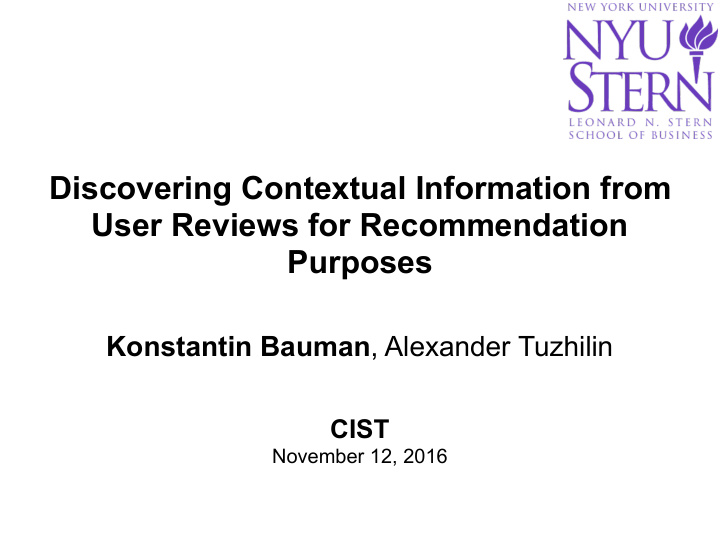



Discovering Contextual Information from User Reviews for Recommendation Purposes Konstantin Bauman , Alexander Tuzhilin CIST November 12, 2016
Context Aware Recommender Systems • “Netflix can improve performance of its RS up to 3% when taking into account such contextual information as the time of the day or location in their recommendation algorithms” R. Hastings CEO of Netflix • Contextual information helps to provide better recommendations (Adomavicius et al. 2011) - music (Kaminskas and Ricci 2011), (Hariri et al. 2013) - movies (Odic et al. 2013) - restaurants (Li et al. 2010) - hotels (Aciar 2010), (Hariri et al. 2011) Konstantin Bauman, Stern School of Business NYU Konstantin Bauman, Stern School of Business NYU
Examples of Contexts in Different Applications Application Context Types Tourist Guide Time, Location, Weather, Traffic Movies Time, Place, Company Music Time, Location, Situation, Weather, Temperature, Noise, Illumination, Emotion, Previous Experience, User Current Interest, Last songs E-commerce Time, Intent of purchase Hotels Objective of the Trip Restaurants Time, Location, Company, Occasion Konstantin Bauman, Stern School of Business NYU Konstantin Bauman, Stern School of Business NYU
Research Idea Question: How to identify important contextual variables in an application? Our approach: Identify the contextual variables discussed in customer reviews. Konstantin Bauman, Stern School of Business NYU Konstantin Bauman, Stern School of Business NYU
Method of Context Discovery 1. Separate reviews into Specific and Generic 2. Identify context related Phrases 3. Identify context related LDA topics 4. Discover contextual variables Konstantin Bauman, Stern School of Business NYU Konstantin Bauman, Stern School of Business NYU
1. Separating reviews into Specific and Generic Konstantin Bauman, Stern School of Business NYU Konstantin Bauman, Stern School of Business NYU
1. Separating reviews into Specific and Generic (cont.) Specific : describes a particular visit to an establishment Generic : describes the overall impressions The approach: K-means clustering based on the following features: • number of sentences • number of words • number of verbs • number of verbs in the past tenses • VRatio – the ratio of the last two measures Konstantin Bauman, Stern School of Business NYU Konstantin Bauman, Stern School of Business NYU
2. Method of Identifying Context Related Phrases 1. Part of Speech tagging 2. Search for POS patterns within five word collocation window 3. Calculate phrase frequencies ( p s ( n i ) , p g ( n i )) in specific and generic reviews respectively 4. Select the frequent phrases and determine ratio ( n i ) = p s ( n i ) p g ( n i ) 5. Sort phrases by this ratio in the descending order. Konstantin Bauman, Stern School of Business NYU Konstantin Bauman, Stern School of Business NYU
2. Identifying Context Related Phrases Examples Phrase Specific Generic Wife 5.3% 1.6% Morning 3.1% 1.4% Birthday 2.9% 0.7% Konstantin Bauman, Stern School of Business NYU Konstantin Bauman, Stern School of Business NYU
3. Method of Identifying Context Related LDA Topics 1. Build LDA model on Specific reviews 2. Identify topics within the reviews ( w s ( t k ) , w g ( t k )) 3. Calculate weighted frequencies in specific and generic reviews respectively 4. Select frequent topics and determine ratio ( t k ) = w s ( t k ) w g ( t k ) 5. Sort topics by this ratio in the descending order. Konstantin Bauman, Stern School of Business NYU Konstantin Bauman, Stern School of Business NYU
4. Discovering contextual variables 1. Examine constructed lists of phrases and topics 2. Identify groups of phrases or topics having the same meaning in an application (e.g. “ colleague ”, “ friend ”, and “ daughter ”) 3. Determine the values of contextual variables based on these phrases and topics (e.g. “parent” value based on the phrases “father” and “mother”) 4. Create their hierarchical structure. Konstantin Bauman, Stern School of Business NYU Konstantin Bauman, Stern School of Business NYU
4. Discovering contextual variables Konstantin Bauman, Stern School of Business NYU Konstantin Bauman, Stern School of Business NYU
Experimental Settings Application Reviews Users Businesses Restaurant 1,344,405 384,821 24,917 Hotel 96,384 65,387 1,424 Beauty & Spa 104,199 71,422 6,536 Konstantin Bauman, Stern School of Business NYU Konstantin Bauman, Stern School of Business NYU
Contextual variables in Restaurants application Konstantin Bauman, Stern School of Business NYU Konstantin Bauman, Stern School of Business NYU
Contextual variables in Hotels application Konstantin Bauman, Stern School of Business NYU Konstantin Bauman, Stern School of Business NYU
Contextual variables in Beauty & Spas application Konstantin Bauman, Stern School of Business NYU Konstantin Bauman, Stern School of Business NYU
Identifying Importance of Contextual Variables Example: Time of the Day Konstantin Bauman, Stern School of Business NYU Konstantin Bauman, Stern School of Business NYU
Phrase-based Method Performance Cumulative numbers of discovered contextual variables Ordinal numbers of phrases in sorted lists Konstantin Bauman, Stern School of Business NYU Konstantin Bauman, Stern School of Business NYU
LDA-based Method Performance Cumulative numbers of discovered contextual variables Ordinal numbers of LDA topics in sorted lists Konstantin Bauman, Stern School of Business NYU Konstantin Bauman, Stern School of Business NYU
CONCLUSION • Proposed a new approach to discover Contextual Information • Presented a method of discovering context from customer reviews ‣ Separating reviews into Specific and Generic ‣ Phrase based method ‣ LDA based method • Tested it on 3 applications: restaurant , hotel , beauty&spas ‣ Extracted almost all of the contextual information ‣ Produced more comprehensive sets than used previously ‣ All the discovered variables are useful for rating predictions Konstantin Bauman, Stern School of Business NYU
Recommend
More recommend